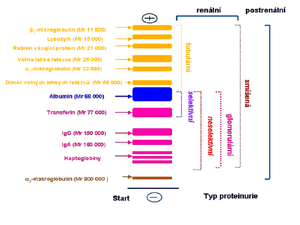Proteinuria typing
To determine the type of proteinuria, it is necessary to know the spectrum of proteins excreted in the urine; Electrophoretic methods are used for this. Electrophoretic distribution of urinary proteins according to their molecular weight enables semi-quantitative evaluation of individual diagnostically significant proteins and classification of proteinuria. Agarose or polyacrylamide gel electrophoresis gradually became the method of choice for urine protein analysis.
In order to separate proteins according to size (and not according to charge), a polyacrylamide gel can be used, the density of which increases from the cathode to the anode (i.e. the "eyes" or "pores" in the gel gradually decrease). Small molecules in such a gel travel further than large molecules.
Another, more frequently used option is to treat the sample with the detergent sodium lauryl sulfate (sodium dodecyl sulfate – SDS), which "surrounds" the protein and replaces its own charge with its negative charge. The resulting complexes have approximately the same charge (more precisely: they have the same surface charge density). If electrophoresis is then carried out in a relatively dense gel, it is divided depending on the relative molecular weight: smaller molecules travel through the gel faster than large ones (molecular sieve technique). β2-microglobulin moves the fastest , albumin lies about in the middle of the dividing path; between start and albumin, proteins with Mr higher than 70,000 are located 70 000.
Urine protein electrophoresis evaluation[edit | edit source]
In glomerular proteinuria, we find proteins in the electrophorogram between the start and albumin inclusive (i.e. Mr > 70 000).
Proteins seen in glomerular proteinurias Mr Albumin 68 000 selective non-selective Transfferin 77 000 selective non-selective IgG 150 000 non-selective IgA 160 000 non-selective Haptoglobiny 85 000–1 000 000 non-selective
Tubular proteinuria is characterized by the presence of protein between albumin and the anodic end of the electrophorogram (ie, Mr < 70 000).
Protein seen in tubular proteinurias Mr Beta-2-microglobulin 11 800 Lysozyme 15 000 Retinol binding protein (RBP) 21 000 Free Ig light chains 25 000 α1-microglobulin 33 000 Dimer of free Ig light chains 50 000 Albumin 68 000
Mixed proteinurias are characterized by the presence of proteins demonstrated in both glomerular and tubular proteinurias, located both cathodically and anodically from the albumin strip.
The presence of α2-macroglobulin (Mr = 800 000) with other findings similar to mixed proteinuria is suggestive of postrenal proteinuria.

